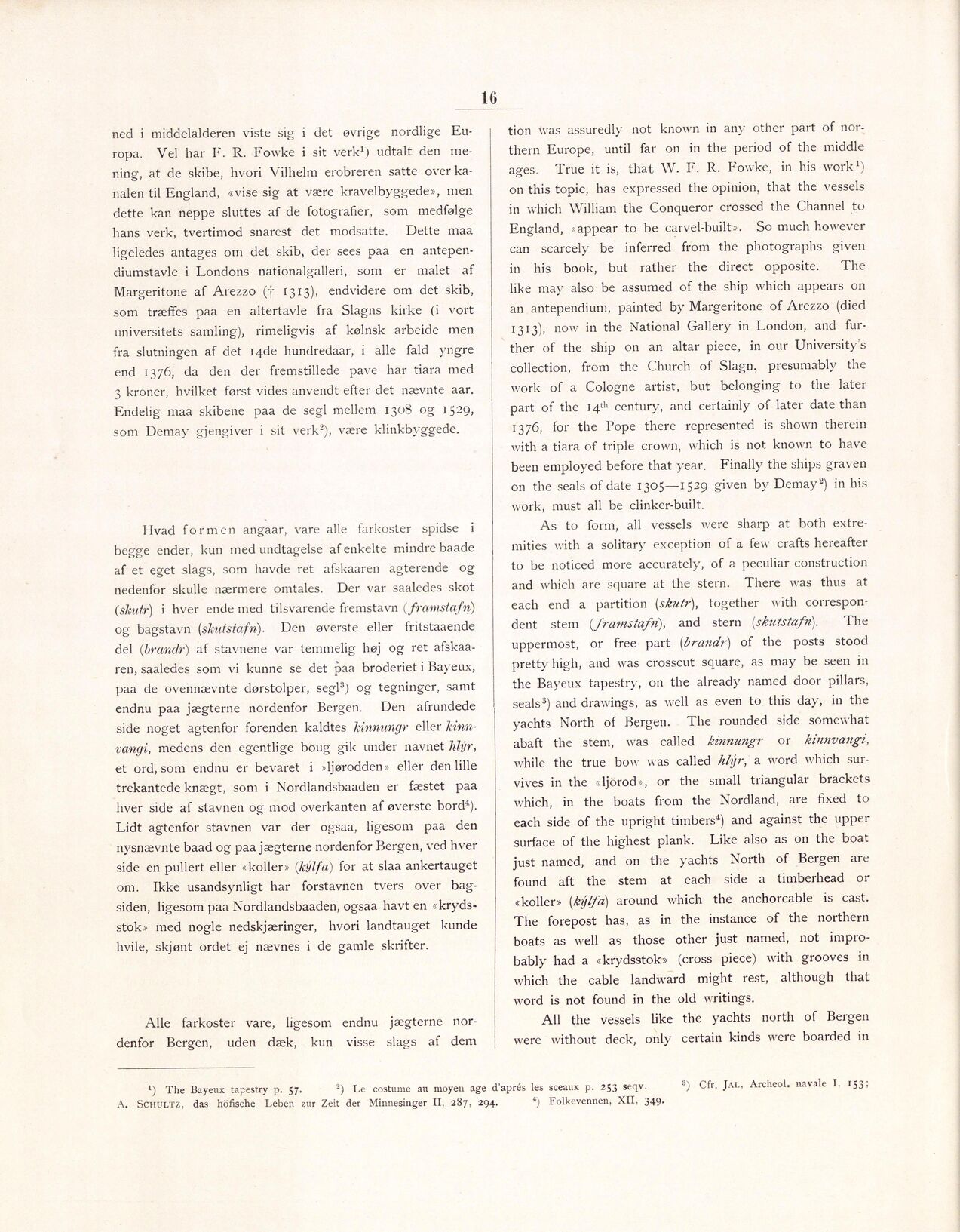
Full resolution (JPEG) - On this page / på denna sida - II. Udsigt over skibsvæsenet i Norge fra de ældste tider indtil middelalderens slutning / Review of the condition and progress of shipping in Norway, from the earliest period, to the close of the middle ages

<< prev. page << föreg. sida << >> nästa sida >> next page >>
Below is the raw OCR text
from the above scanned image.
Do you see an error? Proofread the page now!
Här nedan syns maskintolkade texten från faksimilbilden ovan.
Ser du något fel? Korrekturläs sidan nu!
This page has never been proofread. / Denna sida har aldrig korrekturlästs.
ER
ned i middelalderen viste sig i det øvrige nordlige Eu-
Vel har F. R. Fowke i sit verk?) udtalt den me-
ning, at de skibe, hvori Vilhelm erobreren satte over ka-
ropa.
nalen til England, «vise sig at være kravelbyggede», men
dette kan neppe sluttes af de fotografier, som medfølge
hans verk, tvertimod snarest det modsatte. Dette maa
ligeledes antages om det skib, der sees paa en antepen-
diumstavle i Londons nationalgalleri, som er malet af
Margeritone af Arezzo (f 1313), endvidere om det skib,
som treffes paa en altertavle fra Slagns kirke (i vort
universitets samling), rimeligvis af kølnsk arbeide men
fra slutningen af det 14de hundredaar, i alle fald yngre
end 1376, da den der fremstillede pave har tiara med
3 kroner, hvilket først vides anvendt efter det nævnte aar.
Endelig maa skibene paa de segl mellem 1308 og 1529,
som Demay gjengiver i sit verk?) vere klinkbyggede.
Hvad formen angaar, vare alle farkoster spidse i
begge ender, kun med undtagelse af enkelte mindre baade
af et eget slags, som havde ret afskaaren agterende og
nedenfor skulle nærmere omtales. Der var saaledes skot
(skutr) i hver ende med tilsvarende fremstavn (framstafn)
og bagstavn (skutstafn). Den øverste eller fritstaaende
del (brandr) af stavnene var temmelig høj og ret afskaa-
ren, saaledes som vi kunne se det paa broderiet 1 Bayeux,
paa de ovennævnte dørstolper, segl?) og tegninger, samt
endnu paa jægterne nordenfor Bergen. Den afrundede
side noget agtenfor forenden kaldtes hkinmumgr eller kinn-
vangi, medens den egentlige boug gik under navnet hlyr,
et ord, som endnu er bevaret i »ljørodden» eller den lille
trekantede knægt, som i Nordlandsbaaden er fæstet paa
hver side af stavnen og mod overkanten af øverste bord*).
Lidt agtenfor stavnen var der ogsaa, ligesom paa den
nysnævnte baad og paa jægterne nordenfor Bergen, ved hver
side en pullert eller «koller» (Aylfa) for at slaa ankertauget
om. Ikke usandsynligt har forstavnen tvers over bag-
siden, ligesom paa Nordlandsbaaden, ogsaa havt en «kryds-
stok» med nogle nedskjæringer, hvori landtauget kunde
hvile, skjønt ordet ej nævnes i de gamle skrifter.
Alle farkoster vare, ligesom endnu jægterne nor-
denfor Bergen, uden dæk, kun visse slags af dem
1) The Bayeux tapestry p. 57.
2) Le costume au moyen age d’aprés les sceaux p. 253 seqv.
yi d
A, SCHULTZ, das höfische Leben zur Zeit der Minnesinger II, 287, 294.
tion was assuredly not known in any other part of nor-
thern Europe, until far on in the period of the middle
ages. True it is, that W. F. R. Fowke, in his work?)
on this topic, has expressed the opinion, that the vessels
in which William the Conqueror crossed the Channel to
England, «appear to be carvel-built». So much however
can scarcely be inferred from the photographs given
The
like may also be assumed of the ship which appears on
in his book, but rather the direct opposite.
an antependium, painted by Margeritone of Arezzo (died
1313), now in the National Gallery in London, and fur-
ther of the ship on an altar piece, in our University’s
collection, from the Church of Slagn, presumably the
work of a Cologne artist, but belonging to the later
part of the 144 century, and certainly of later date than
1376, for the Pope there represented is shown therein
with a tiara of triple crown, which is not known to have
been employed before that year. Finally the ships graven
on the seals of date 1305—1529 given by Demay*) in his
work, must all be clinker-built.
As to form, all vessels were sharp at both extre-
mities with a solitary exception of a few crafts hereafter
to be noticed more accurately, of a peculiar construction
and which are square at the stern. There was thus at
each end a partition (skutr), together with correspon-
dent stem (/ramstafn), and stern (skutstafn). The
uppermost, or free part (drandr) of the posts stood
pretty high, and was crosscut square, as may be seen in
the Bayeux tapestry, on the already named door pillars,
seals?) and drawings, as well as even to this day, in the
yachts North of Bergen. The rounded side somewhat
abaft the stem, was called æinnungr or kinnvangt,
while the true bow was called AZjr, a word which sur-
vives in the «ljörod», or the small triangular brackets
which, in the boats from the Nordland, are fixed to
each side of the upright timbers*) and against the upper
surface of the highest plank. Like also as on the boat
just named, and on the yachts North of Bergen are
found aft the stem side a timberhead or
«koller» (4y/fa) around which the anchorcable is cast.
The forepost has, as in the instance of the northern
boats as well as those other just named, not impro-
bably had a «krydsstok» (cross piece) with grooves in
which the cable landward might rest, although that
word is not found in the old writings.
All the vessels like the yachts north of Bergen
were without deck, only certain kinds were boarded in
at each
3) Cfr. Jat, Archeol. navale I, 153;
#) Folkevennen, XII, 349.
<< prev. page << föreg. sida << >> nästa sida >> next page >>